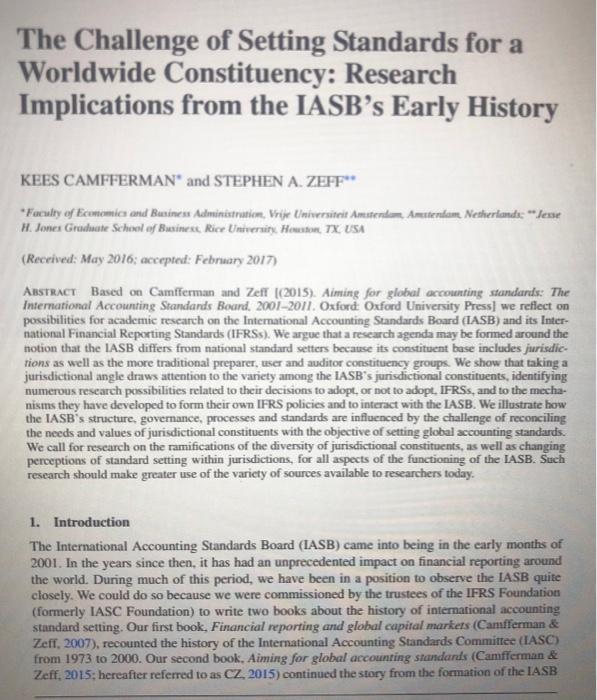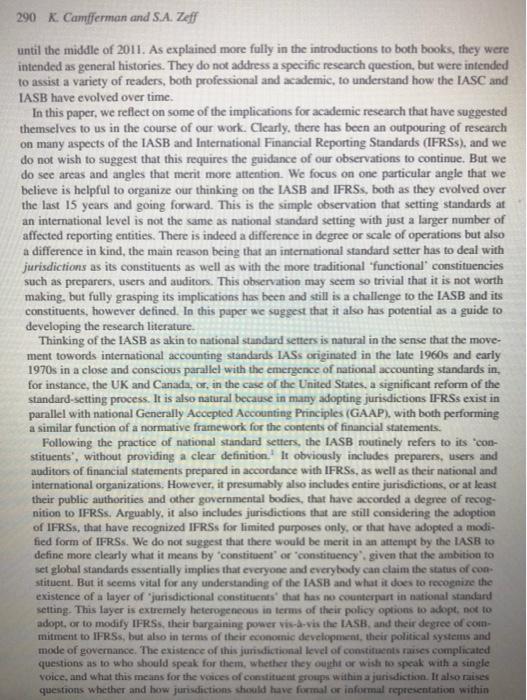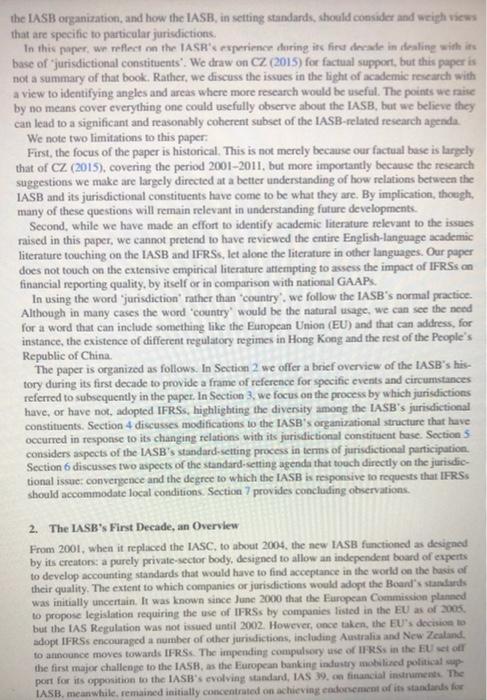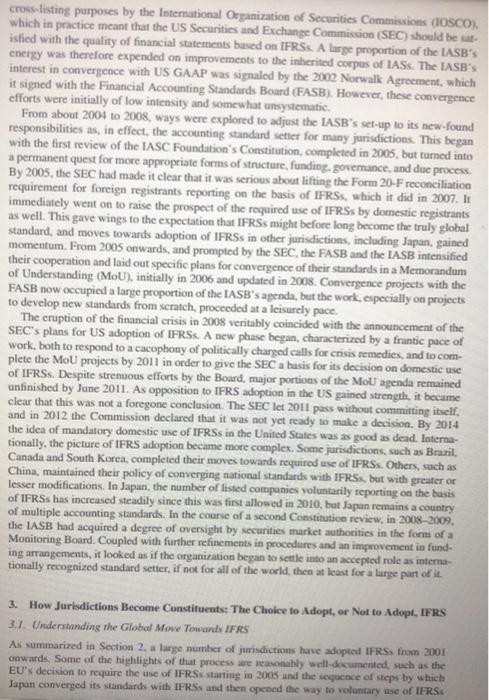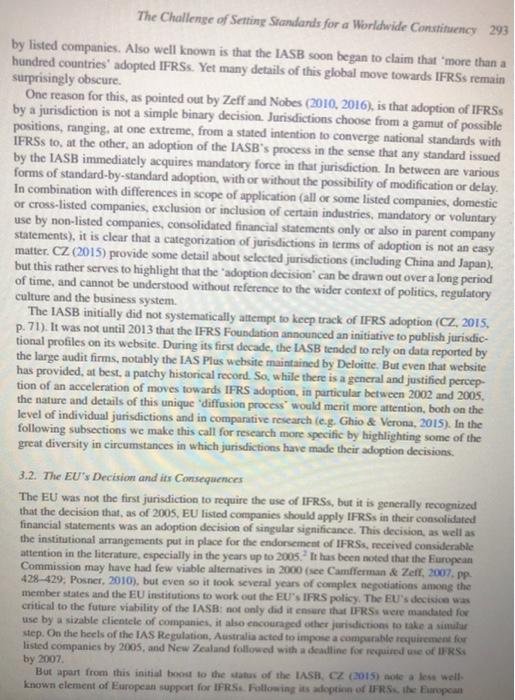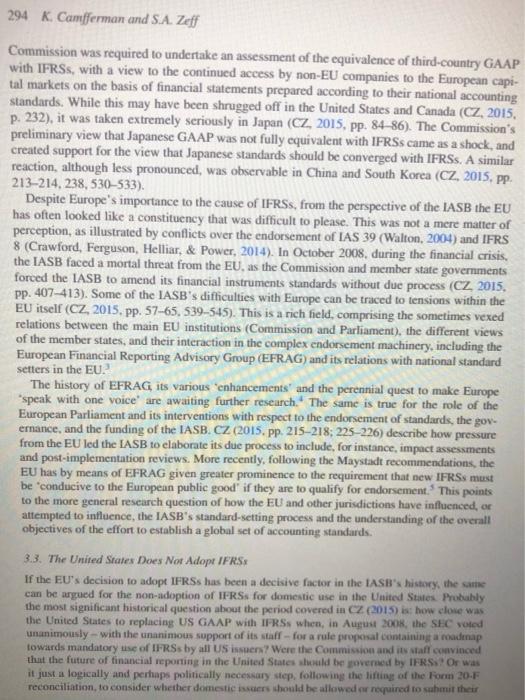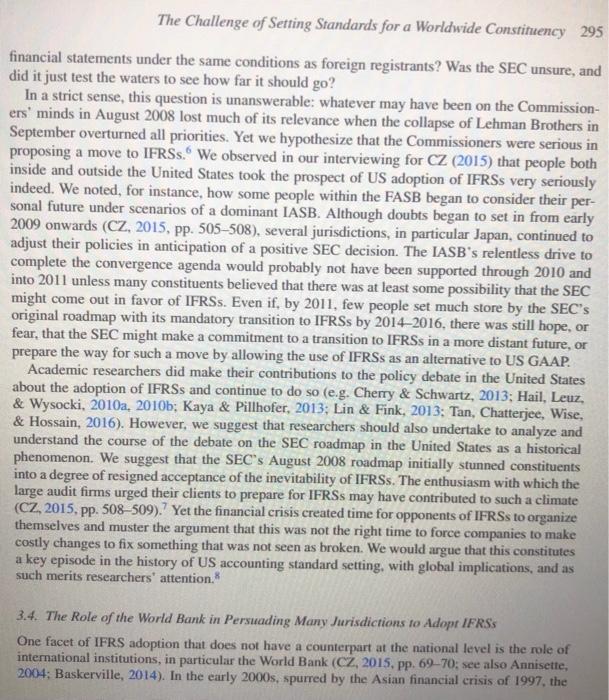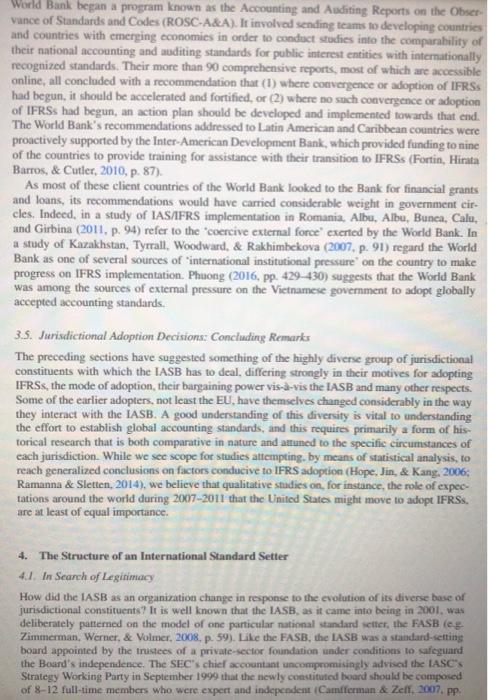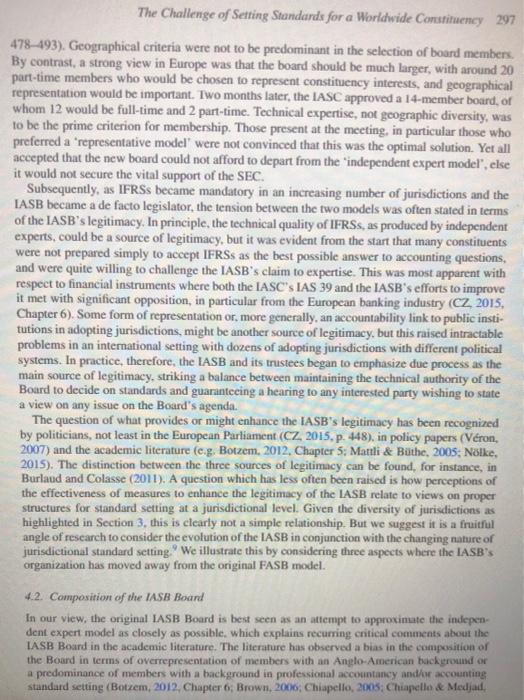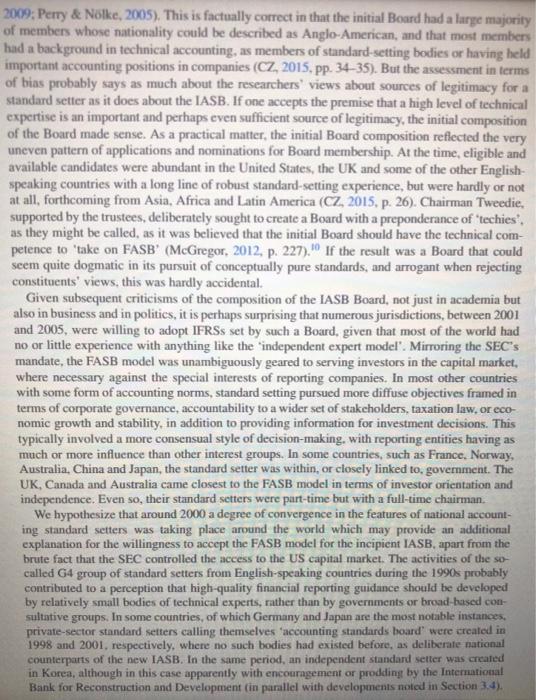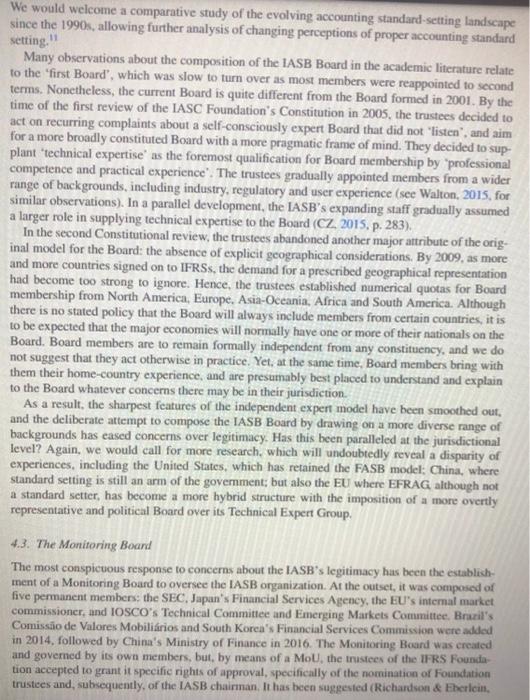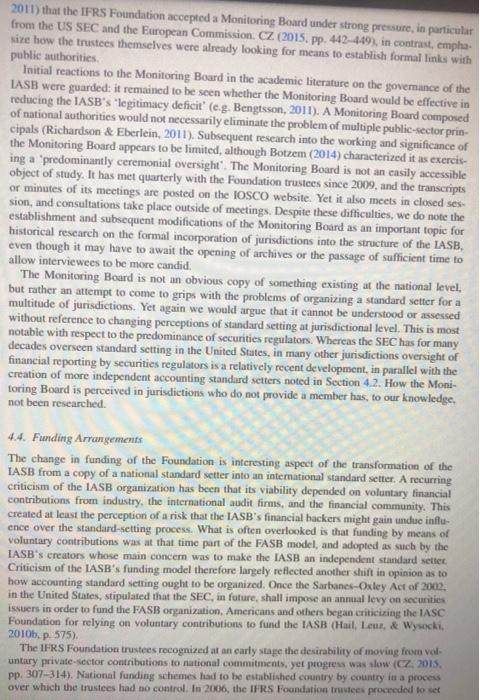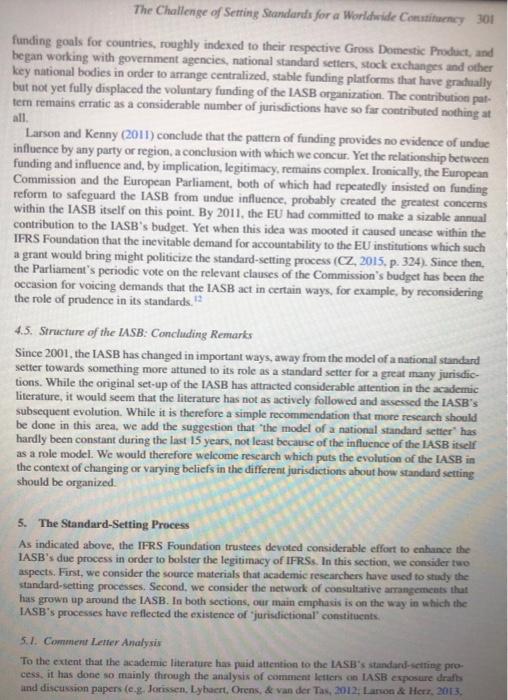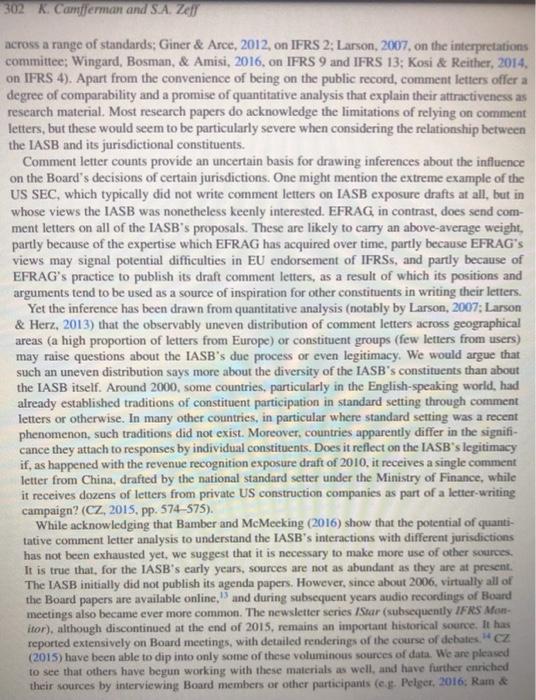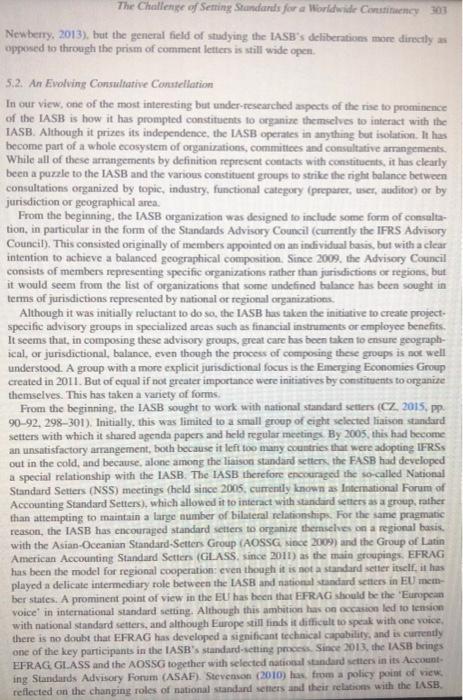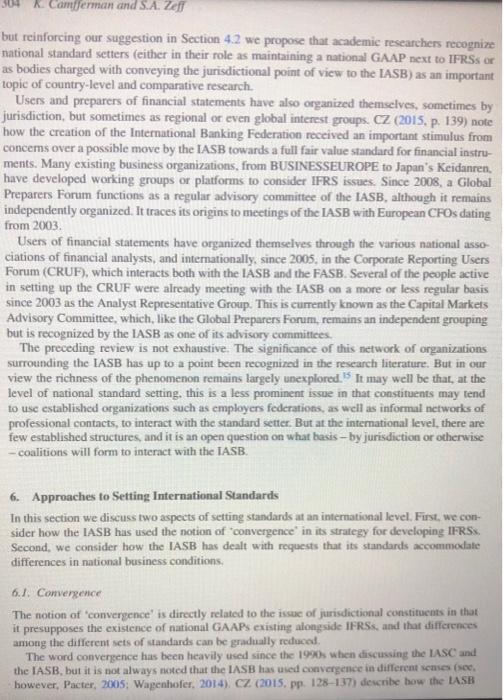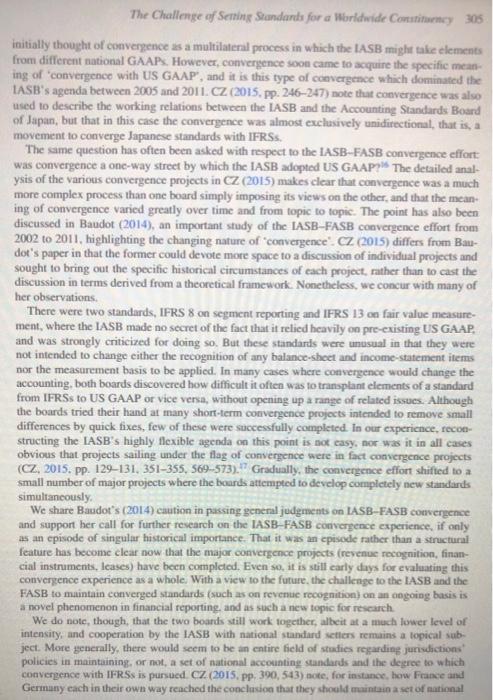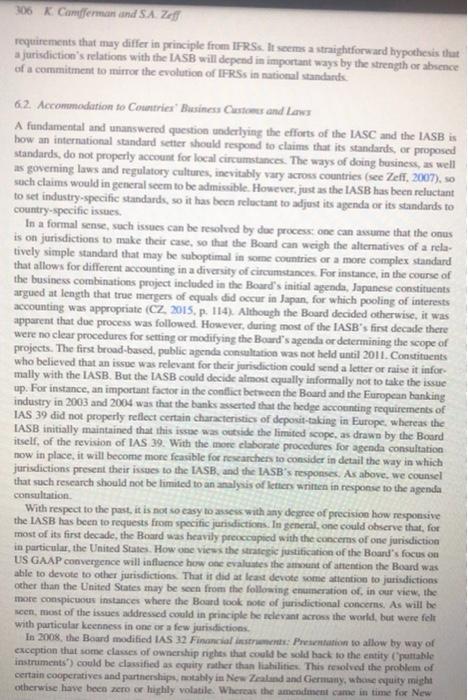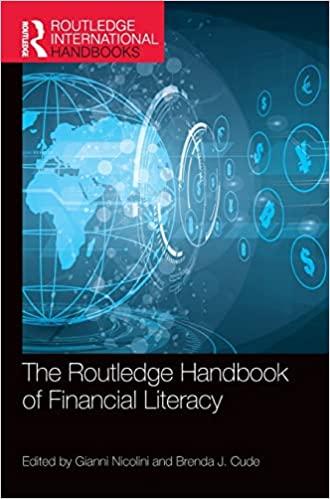summarise that article and make it to 2000 words
Your report should clearly contain 4 main Parts: Introduction, Literature Review, Result and Analysis, Conclusion.
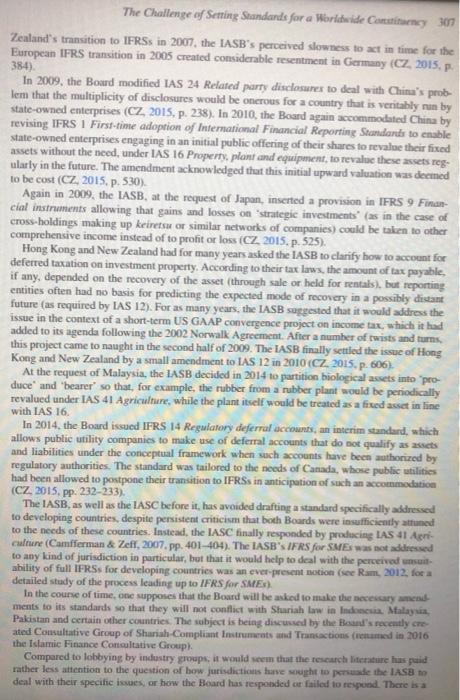
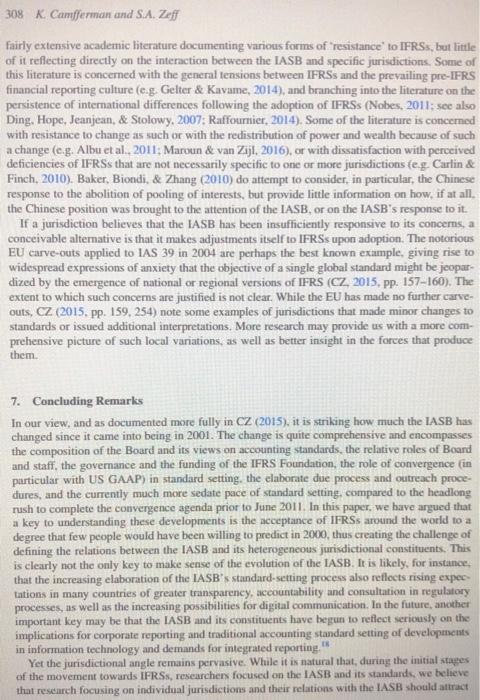
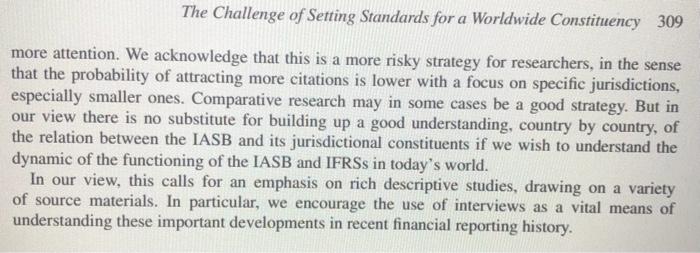
The Challenge of Setting Standards for a Worldwide Constituency: Research Implications from the IASB's Early History KEES CAMFFERMAN and STEPHEN A. ZEFF * Faculty of Economics and Business Administration. Vrije Universiteit Amsterdam Amsterdam. Netherlands: "Jesse H. Jones Graduate School of Business Rice University Houston, TX. USA (Received: May 2016; accepted: February 2017) ABSTRACT Based on Camfferman and Zelf (2015). Aiming for global accounting standards: The International Accounting Standards Board, 2001-2011. Oxford: Oxford University Press) we reflect on possibilities for academic research on the International Accounting Standards Board (IASB) and its Inter- national Financial Reporting Standards (IFRSs). We argue that a research agenda may be formed around the notion that the IASB differs from national standard setters because its constituent base includes jurisdic- tions as well as the more traditional preparer, user and auditor constituency groups. We show that taking a jurisdictional angle draws attention to the variety among the IASB's jurisdictional constituents, identifying numerous research possibilities related to their decisions to adopt or not to adopt. IFRSs, and to the mecha- nisms they have developed to form their own IFRS policies and to interact with the IASB. We illustrate how the IASB's structure, governance, processes and standards are influenced by the challenge of reconciling the needs and values of jurisdictional constituents with the objective of setting global accounting standards. We call for research on the ramifications of the diversity of jurisdictional constituents, as well as changing perceptions of standard setting within jurisdictions, for all aspects of the functioning of the IASB. Such research should make greater use of the variety of sources available to researchers today. 1. Introduction The International Accounting Standards Board (IASB) came into being in the early months of 2001. In the years since then, it has had an unprecedented impact on financial reporting around the world. During much of this period, we have been in a position to observe the IASB quite closely. We could do so because we were commissioned by the trustees of the IFRS Foundation (formerly IASC Foundation) to write two books about the history of international accounting standard setting. Our first book, Financial reporting and global capital markets (Camfferman & Zeff, 2007), recounted the history of the International Accounting Standards Committee (IASC) from 1973 to 2000. Our second book, Aiming or global accounting standards (Camfferman & Zeff, 2015; hereafter referred to as CZ, 2015) continued the story from the formation of the IASB 290 K. Camfferman and S.A. Zeff until the middle of 2011. As explained more fully in the introductions to both books, they were intended as general histories. They do not address a specific research question, but were intended to assist a variety of readers, both professional and academie, to understand how the IASC and IASB have evolved over time. In this paper, we reflect on some of the implications for academic research that have suggested themselves to us in the course of our work. Clearly, there has been an outpouring of research on many aspects of the IASB and International Financial Reporting Standards (IFRSs) and we do not wish to suggest that this requires the guidance of our observations to continue. But we do see areas and angles that merit more attention. We focus on one particular angle that we believe is helpful to organize our thinking on the IASB and IFRSs, both as they evolved over the last 15 years and going forward. This is the simple observation that setting standards at an international level is not the same as national standard setting with just a larger number of affected reporting entities. There is indeed a difference in degree or scale of operations but also a difference in kind, the main reason being that an international standard setter has to deal with jurisdictions as its constituents as well as with the more traditional functional constituencies such as preparers, users and auditors. This observation may seem so trivial that it is not worth making, but fully grasping its implications has been and still is a challenge to the IASB and its constituents, however defined. In this paper we suggest that it also has potential as a guide to developing the research literature. Thinking of the IASB as akin to national standard setters is natural in the sense that the move- ment towords international accounting standards IASs originated in the late 1960s and early 1970s in a close and conscious parallel with the emergence of national accounting standards in. for instance, the UK and Canada, or, in the case of the United States, a significant reform of the standard-setting process. It is also natural because in many adopting jurisdictions IFRSs exist in parallel with national Generally Accepted Accounting Principles (GAAP) with both performing a similar function of a normative framework for the contents of financial statements. Following the practice of national standard setters, the IASB routinely refers to its con- stituents', without providing a clear definition. It obviously includes preparers, users and auditors of financial statements prepared in accordance with IFRSs, as well as their national and international organizations. However, it presumably also includes entire jurisdictions, or at least their public authorities and other governmental bodies, that have accorded a degree of recog- nition to IFRSs. Arguably, it also includes jurisdictions that are still considering the adoption of IFRSs, that have recognized IFRSs for limited purposes only, or that have adopted a modi- fied form of IFRSs. We do not suggest that there would be merit in an attempt by the IASB to define more clearly what it means by constituent' or 'constituency. given that the ambition to set global standards essentially implies that everyone and everybody can claim the status of con stituent. But it seems vital for any understanding of the IASB and what it does to recognize the existence of a layer of jurisdictional constituents that has no counterpart in national standard setting. This layer is extremely heterogeneous in terms of their policy options to adopt, not to adopt, or to modify IFRSs, their bargaining power vis-a-vis the IASB, and their degree of com- mitment to IFRSs, but also in terms of their economic development, their political systems and mode of governance. The existence of this jurisdictional level of constituents raises complicated questions as to who should speak for them, whether they ought or wish to speak with a single voice, and what this means for the voices of constituent groups within a jurisdiction. It also raises questions whether and how jurisdictions should have formal or informal representation within the IASB organization, and how the IASB, in setting standards should consider and weigh views that are specific to particular jurisdictions In this paperwe reflect on the TASR's primer during its first decade in dealing within base of jurisdictional constituents. We draw on CZ (2015) for factual support, but this paper is not a summary of that book. Rather, we discuss the issues in the light of academic research with a view to identifying angles and areas where more research would be useful. The points we raise by no means cover everything one could usefully observe about the IASB, but we believe they can lead to a significant and reasonably coherent subset of the IASB-related research agenda We note two limitations to this paper First, the focus of the paper is historical. This is not merely because our factual base is largely that of CZ (2015), covering the period 2001-2011, but more importantly because the research suggestions we make are largely directed at a better understanding of how relations between the 1ASB and its jurisdictional constituents have come to be what they are. By implication, though, many of these questions will remain relevant in understanding future developments Second, while we have made an effort to identify academic literature relevant to the issues raised in this paper, we cannot pretend to have reviewed the entire English-language academic literature touching on the IASB and IFRSs, let alone the literature in other languages. Our paper does not touch on the extensive empirical literature attempting to assess the impact of IFRSsan financial reporting quality, by itself or in comparison with national GAAPS In using the word "jurisdiction rather than country. we follow the IASB's normal practice. Although in many cases the word "country would be the natural usage, we can see the need for a word that can include something like the European Union (EU) and that can address, for instance, the existence of different regulatory regimes in Hong Kong and the rest of the People's Republic of China The paper is organized as follows. In Section 2 we offer a brief overview of the IASB's his tory during its first decade to provide a frame of reference for specific events and circumstances referred to subsequently in the paper. In Section 3 we focus on the process by which jurisdictions have, or have not, adopted IFRSs, highlighting the diversity among the IASB's jurisdictional constituents. Section 4 discusses modifications to the IASB's organizational structure that have occurred in response to its changing relations with its jurisdictional constituent base. Section 3 considers aspects of the IASB's standard setting process in terms of jurisdictional participation. Section 6 discusses two aspects of the standard setting agenda that touch directly on the jurisdic- tional issue: convergence and the degree to which the IASB is responsive to requests that IFRSs should accommodate local conditions Section provides concluding observations 2. The LASB's First Decade, an Overview From 2001, when it replaced the IASC, to about 2004, the new IASB functioned as designed by its creators: a purely private sector body, designed to allow an independent board of experts to develop accounting standards that would have to find acceptance in the world on the basis of their quality. The extent to which companies or jurisdictions would adopt the Board's standards was initially uncertain. It was known since June 2000 that the Furopean Commission planned to propose legislation requiring the use of IFRSs by companies listed in the EU as of 2005 but the IAS Regulation was not issued until 2002. However, once taken the EU's decision to adopt IFRSs encouraged a number of other jurisdictions, including Australia and New Zealand to announce moves towards IFRSs. The impending compulsory use of IFRSs in the EU set of the first major challenge to the IASB, as the European Banking industry mobiired political port for its opposition to the IASB's evolving standard. IAS 19. on fancial instruments. The IASB, meanwhile, remained initially concentrated on achieving codonment of its standards for cross-listing purposes by the International Organization of Securities Commissions (IOSCO). which in practice meant that the US Securities and Exchange Commission (SEC) should be sa isfied with the quality of financial statements based on IFRSs. A large proportion of the IASB's energy was therefore expended on improvements to the inherited corpus of IASs. The IASB'S interest in convergence with US GAAP was signaled by the 2002 Norwalk Agreement, which it signed with the Financial Accounting Standards Board (FASB). However, these convergence efforts were initially of low intensity and somewhat unsystematic From about 2004 to 2008, ways were explored to adjust the IASB's set-up to its new-found responsibilities as, in effect, the accounting standard setter for many jurisdictions. This began with the first review of the IASC Foundation's Constitution, completed in 2005, but turned into a permanent quest for more appropriate forms of structure, funding, governance, and due process. By 2005, the SEC had made it clear that it was serious about lifting the Form 20-Freconciliation requirement for foreign registrants reporting on the basis of IFRSs, which it did in 2007. It immediately went on to raise the prospect of the required use of IFRSs by domestic registrants as well. This gave wings to the expectation that IFRSs might before long become the truly global standard, and moves towards adoption of IFRSs in other jurisdictions, including Japan, gained momentum. From 2005 onwards, and prompted by the SEC, the FASB and the IASB intensified their cooperation and laid out specific plans for convergence of their standards in a M Memorandum of Understanding (MoU), initially in 2006 and updated in 2008. Convergence projects with the FASB now occupied a large proportion of the IASB's agenda, but the work, especially on projects to develop new standards from scratch, proceeded at a leisurely pace. The eruption of the financial crisis in 2008 veritably coincided with the announcement of the SEC's plans for US adoption of IFRSs. A new phase began, characterized by a frantic pace of work, both to respond to a cacophony of politically charged calls for crisis remedies, and to com- plete the MoU projects by 2011 in order to give the SEC a basis for its decision on domestic use of IFRSs. Despite strenuous efforts by the Board, major portions of the MoU agenda remained unfinished by June 2011. As opposition to IFRS adoption in the US gained strength, it became clear that this was not a foregone conclusion. The SEC let 2011 pass without committing itself and in 2012 the Commission declared that it was not yet ready to make a decision. By 2014 the idea of mandatory domestic use of IFRSs in the United States was as good as dead. Interna- tionally, the picture of IFRS adoption became more complex. Some jurisdictions, such as Brasil, Canada and South Korca, completed their moves towards required use of IFRSs. Others, such as China, maintained their policy of converging national standards with IFRSs, but with greater or lesser modifications. In Japan, the number of listed companies voluntarily reporting on the basis of IFRSs has increased steadily since this was first allowed in 2010, but Japan remains a country of multiple accounting standards. In the course of a second Constitution review, in 2008-2009 the IASB had acquired a degree of oversight by securities market authorities in the form of a Monitoring Board. Coupled with further refinements in procedures and an improvement in fund- ing arrangements, it looked as if the organization began to settle into an accepted role as interna tionally recognized standard setter, if not for all of the world, then at least for a large part of it. 3. How Jurisdictions Become Constituents: The Choice to Adopt, or Not to Adopt, IFRS 3.1. Understanding the Global Mowe Towards IFRS As summarized in Section 2. a large number of jurisdictions have adopted IFRSs from 2001 onwards. Some of the highlights of that process are reasonably well-documented, such as the EU's decision to require the use of IFRSs starting in 2005 and the sequence of steps by which Japan converged its standards with IFRSs and then opened the way to voluntary use of IFRS The Challenge of Setting Standards for a Worldwide Constituency 293 by listed companies. Also well known is that the IASB soon began to claim that more than a hundred countries' adopted IFRSs. Yet many details of this global move towards IFRSs remain surprisingly obscure. One reason for this, as pointed out by Zeff and Nobes (2010, 2016), is that adoption of IFRSs by a jurisdiction is not a simple binary decision. Jurisdictions choose from a gamut of possible positions, ranging, at one extreme, from a stated intention to converge national standards with IFRSs to, at the other, an adoption of the IASB's process in the sense that any standard issued by the IASB immediately acquires mandatory force in that jurisdiction. In between are various forms of standard-by-standard adoption, with or without the possibility of modification or delay. In combination with differences in scope of application (all or some listed companies, domestic or cross-listed companies, exclusion or inclusion of certain industries, mandatory or voluntary use by non-listed companies, consolidated financial statements only or also in parent company statements), it is clear that a categorization of jurisdictions in terms of adoption is not an easy matter. CZ (2015) provide some detail about selected jurisdictions (including China and Japan), but this rather serves to highlight that the adoption decision can be drawn out over a long period of time, and cannot be understood without reference to the wider context of politics, regulatory culture and the business system. The IASB initially did not systematically attempt to keep track of IFRS adoption (CZ. 2015, p. 71). It was not until 2013 that the IFRS Foundation announced an initiative to publish jurisdic- tional profiles on its website. During its first decade, the IASB tended to rely on data reported by the large audit firms, notably the IAS Plus website maintained by Deloitte. But even that website has provided, at best, a patchy historical record. So, while there is a general and justified percep- tion of an acceleration of moves towards IFRS adoption, in particular between 2002 and 2005, the nature and details of this unique diffusion process would merit more attention, both on the level of individual jurisdictions and in comparative research (e.g. Ghio & Verona, 2015). In the following subsections we make this call for research more specific by highlighting some of the great diversity in circumstances in which jurisdictions have made their adoption decisions 3.2. The EU's Decision and its Consequences The EU was not the first jurisdiction to require the use of IFRSs, but it is generally recognised that the decision that, as of 2005, EU listed companies should apply IFRSs in their consolidated financial statements was an adoption decision of singular significance. This decision, as well as the institutional arrangements put in place for the endorsement of IFRSs, received considerable attention in the literature, especially in the years up to 2005. It has been noted that the European Commission may have had few viable alternatives in 2000 (sce Camerman & Zell, 2007, pp. 428 429. Posner, 2010), but even so it look several years of complex negotiations among the member states and the EU institutions to work out the EU's IFRS policy. The EU's decision was critical to the future viability of the IASR: not only did it ensure that IFRSs were mandated for use by a sizable clientele of companies, it also encouraged other jurisdictions to take a sim step. On the heels of the IAS Regulation, Australia acted to impose a comparable requirement for listed companies by 2005, and New Zealand followed with a deadline for required one of IFRS by 2007 But apart from this initial boost to the waters of the IASH, CZ (2015) note a less well known element of European support for IFRS Following is option of IFRS, the European 294 K Camfferman and S.A. Zeff Commission was required to undertake an assessment of the equivalence of third-country GAAP with IFRSs, with a view to the continued access by non-EU companies to the European capi- tal markets on the basis of financial statements prepared according to their national accounting standards. While this may have been shrugged off in the United States and Canada (CZ, 2015, p. 232), it was taken extremely seriously in Japan (CZ, 2015, pp. 84-86). The Commission's preliminary view that Japanese GAAP was not fully equivalent with IFRSs came as a shock, and created support for the view that Japanese standards should be converged with IFRSs. A similar reaction, although less pronounced, was observable in China and South Korea (CZ. 2015, pp. 213-214, 238, 530-533). Despite Europe's importance to the cause of IFRSs, from the perspective of the IASB the EU has often looked like a constituency that was difficult to please. This was not a mere matter of perception, as illustrated by conflicts over the endorsement of IAS 39 (Walton, 2004) and IFRS 8 (Crawford, Ferguson, Helliar, & Power, 2014). In October 2008, during the financial crisis. the IASB faced a mortal threat from the EU, as the Commission and member state governments forced the IASB to amend its financial instruments standards without due process (CZ 2015. pp. 407-413). Some of the IASB's difficulties with Europe can be traced to tensions within the EU itself (CZ, 2015. pp. 57-65. 539-545). This is a rich field. comprising the sometimes vered relations between the main EU institutions (Commission and Parliament), the different views of the member states, and their interaction in the complex endorsement machinery, including the European Financial Reporting Advisory Group (EFRAG) and its relations with national standard setters in the EU. The history of EFRAG, its various enhancements and the perennial quest to make Europe speak with one voice' are awaiting further research. The same is true for the role of the European Parliament and its interventions with respect to the endorsement of standards, the gov. ernance, and the funding of the IASB.CZ (2015. pp. 215-218; 225-226) describe how pressure from the EU led the IASB to elaborate its due process to include, for instance, impact assessments and post-implementation reviews. More recently, following the Maystadt recommendations, the EU has by means of EFRAG given greater prominence to the requirement that new IFRSs must be conducive to the European public good' if they are to qualify for endorsement. This points to the more general research question of how the EU and other jurisdictions have influenced, or attempted to influence, the IASB's standard-setting process and the understanding of the overall objectives of the effort to establish a global set of accounting standards 3.3. The United States Does Not Adopt IFRS If the EU's decision to adopt IFRSs has been a decisive factor in the IASB's history, the same can be argued for the non-adoption of IFRS for domestic use in the United States. Probably the most significant historical question about the period covered in CZ (2015) is: how close was the United States to replacing US GAAP with IFRSs when, in August 2008, the SEC voted unanimously - with the unanimous support of its staff - for a rule proposal containing a roadenap towards mandatory use of IFRSs by all US issues? Were the Commission and its staff convinced that the future of financial reporting in the United States should be powered by IFRSS? Or was it just a logically and perhaps politically necessary step, following the lifting of the Form 20-F reconciliation, to consider whether domestic issuers should be allowed or required to submit their World Bank began a program known as the Accounting and Auditing Reports on the Obser vance of Standards and Codes (ROSC-A&A). It involved sending teams to developing countries and countries with emerging economies in order to conduct studies into the comparability of their national accounting and auditing standards for public interest entities with internationally recognized standards. Their more than 90 comprehensive reports, most of which are accessible online, all concluded with a recommendation that (1) where convergence or adoption of IFRSs had begun, it should be accelerated and fortified, or (2) where no such convergence or adoption of IFRSs had begun, an action plan should be developed and implemented towards that end. The World Bank's recommendations addressed to Latin American and Caribbean countries were proactively supported by the Inter-American Development Bank, which provided funding to nine of the countries to provide training for assistance with their transition to IFRSs (Fortin, Hinata Barros, & Cutler, 2010, p. 87). As most of these client countries of the World Bank looked to the Bank for financial grants and loans, its recommendations would have carried considerable weight in government cir- cles. Indeed, in a study of IAS/IFRS implementation in Romania. Albu, Albu, Bunea, Calu. and Girbina (2011, p. 94) refer to the coercive external force exerted by the World Bank. In a study of Kazakhstan, Tyrrall, Woodward, & Rakhimbekova (2007, p. 91) regard the World Bank as one of several sources of international institutional pressure on the country to make progress on IFRS implementation. Phuong (2016, pp. 429-430) suggests that the World Bank was among the sources of external pressure on the Vietnamese government to adopt globally accepted accounting standards. 3.5. Jurisdictional Adoption Decisions: Concluding Remarks The preceding sections have suggested something of the highly diverse group of jurisdictional constituents with which the IASB has to deal, differing strongly in their motives for adopting IFRSs, the mode of adoption, their bargaining power vis-a-vis the IASB and many other respects. Some of the earlier adopters, not least the EU, have themselves changed considerably in the way they interact with the IASB. A good understanding of this diversity is vital to understanding the effort to establish global accounting standards, and this requires primarily a form of his torical research that is both comparative in nature and aftuned to the specific circumstances of each jurisdiction. While we see scope for studies attempting, by means of statistical analysis, to reach generalized conclusions on factors conducive to IFRS adoption (Hope, Jin & Kang, 2006; Ramanna & Sletten, 2014), we believe that qualitative studies on, for instance, the role of expec tations around the world during 2007-2011 that the United States might move to adopt IFRSs. are at least of equal importance. 4. The Structure of an International Standard Setter 4.1. In Search of Legitimacy How did the IASB as an organization change in response to the evolution of its diverse base of jurisdictional constituents? It is well known that the LASB, as it came into being in 2001. was deliberately patterned on the model of one particular national standard setter, the FASB (eg. Zimmerman, Werner, & Volmer. 2008, p. 59). Like the FASB, the LASB was a standard-setting board appointed by the trustees of a private sector foundation under conditions to safeguard the Bourd's independence. The SEC's chief accountant uncompromisingly advised the IASC's Strategy Working Party in September 1999 that the newly constituted board should be composed of 8-12 full-time members who were expert and independent Camfferman & Zelf. 2007. pp. The Challenge of Setting Standards for a Worldwide Constituency 297 478-493). Geographical criteria were not to be predominant in the selection of board members. By contrast, a strong view in Europe was that the board should be much larger, with around 20 part-time members who would be chosen to represent constituency interests, and geographical representation would be important. Two months later, the ASC approved a 14-member board, of whom 12 would be full-time and 2 part-time. Technical expertise, not geographic diversity, was to be the prime criterion for membership. Those present at the meeting, in particular those who preferred a "representative model' were not convinced that this was the optimal solution. Yet all accepted that the new board could not afford to depart from the independent expert model, else it would not secure the vital support of the SEC. Subsequently, as IFRSs became mandatory in an increasing number of jurisdictions and the IASB became a de facto legislator, the tension between the two models was often stated in terms of the IASB's legitimacy, In principle, the technical quality of IFRSs, as produced by independent experts, could be a source of legitimacy, but it was evident from the start that many constituents were not prepared simply to accept IFRSs as the best possible answer to accounting questions, and were quite willing to challenge the IASB's claim to expertise. This was most apparent with respect to financial instruments where both the IASC's IAS 39 and the IASB's efforts to improve it met with significant opposition, in particular from the European banking industry (CZ 2015, Chapter 6). Some form of representation or more generally, an accountability link to public insti- tutions in adopting jurisdictions, might be another source of legitimacy, but this raised intractable problems in an international setting with dozens of adopting jurisdictions with different political systems. In practice, therefore, the IASB and its trustees began to emphasize due process as the main source of legitimacy, striking a balance between maintaining the technical authority of the Board to decide on standards and guaranteeing a hearing to any interested party wishing to state a view on any issue on the Board's agenda. The question of what provides or might enhance the IASB's legitimacy has been recognized by politicians, not least in the European Parliament (CZ 2015, p. 448), in policy papers (Vron, 2007) and the academic literature (e.g. Botzem. 2012, Chapter 5: Martli & Bthe, 2005: Nelke, 2015). The distinction between the three sources of legitimacy can be found, for instance, in Burlaud and Colasse (2011). A question which has less often been raised is how perceptions of the effectiveness of measures to enhance the legitimacy of the LASB relate to views on proper structures for standard setting at a jurisdictional level. Given the diversity of jurisdictions as highlighted in Section 3, this is clearly not a simple relationship. But we suggest it is a fruitful angle of research to consider the evolution of the IASB in conjunction with the changing nature of jurisdictional standard setting. We illustrate this by considering there aspects where the IASB's organization has moved away from the original FASB model. 4.2. Composition of the IASB Board In our view, the original IASB Board is best seen as an attempt to approximate the indepen- dent expert model as closely as possible, which explains recurring critical comments about the LASB Board in the academic literature. The literature has observed a bias in the composition of the Board in terms of overrepresentation of members with an Anglo-American background or a predominance of members with a background in professional accountancy and accounting standard setting (Botzem, 2012. Chapter 6: Brown, 2006, Chiapello, 2005: Chiapello & Medjad, 2009; Perry & Notke, 2005). This is factually correct in that the initial Board had a large majority of members whose nationality could be described as Anglo-American, and that most members had a background in technical accounting, as members of standard-setting bodies or having held important accounting positions in companies (CZ, 2015, pp. 34-35). But the assessment in terms of bias probably says as much about the researchers' views about sources of legitimacy for a standard setter as it does about the IASB. If one accepts the premise that a high level of technical expertise is an important and perhaps even sufficient source of legitimacy, the initial composition of the Board made sense. As a practical matter, the initial Board composition reflected the very uneven pattern of applications and nominations for Board membership. At the time, eligible and available candidates were abundant in the United States, the UK and some of the other English speaking countries with a long line of robust standard-setting experience, but were hardly or not at all, forthcoming from Asia, Africa and Latin America (CZ, 2015, p. 26). Chairman Tweedie, supported by the trustees, deliberately sought to create a Board with a preponderance of techies'. as they might be called, as it was believed that the initial Board should have the technical com- petence to take on FASB (McGregor, 2012, p. 227). If the result was a Board that could seem quite dogmatic in its pursuit of conceptually pure standards, and arrogant when rejecting constituents' views, this was hardly accidental. Given subsequent criticisms of the composition of the IASB Board, not just in academia but also in business and inp politics, it is p sperhaps surprising that numerous jurisdictions, between 2001 and 2005, were willing to adopt IFRSs set by such a Board, given that most of the world had no or little experience with anything like the independent expert model'. Mirroring the SEC's mandate, the FASB model was unambiguously geared to serving investors in the capital market, where necessary against the special interests of reporting companies. In most other countries with some form of accounting norms, standard setting pursued more diffuse objectives framed in terms of corporate governance, accountability to a wider set of stakeholders, taxation law, or eco- nomic growth and stability, in addition to providing information for investment decisions. This typically involved a more consensual style of decision-making, with reporting entities having as much or more influence than other interest groups. In some countries, such as France. Norway, Australia, China and Japan, the standard setter was within, or closely linked to government. The UK, Canada and Australia came closest to the FASB model in terms of investor orientation and independence. Even so, their standard setters were part-time but with a full-time chairman. We hypothesize that around 2000 a degree of convergence in the features of national account- ing standard setters was taking place around the world which may provide an additional explanation for the willingness to accept the FASB model for the incipient IASB, apart from the brute fact that the SEC controlled the access to the US capital market. The activities of the so called G4 group of standard setters from English-speaking countries during the 1990s probably contributed to a perception that high-quality financial reporting guidance should be developed by relatively small bodies of technical experts, rather than by governments or broad-based con- sultative groups. In some countries, of which Germany and Japan are the most notable instances, private sector standard setters calling themselves accounting standards board' were created in 1998 and 2001, respectively, where no such bodies had existed before, as deliberate national counterparts of the new IASB. In the same period, an independent standard setter was created in Korea, although in this case apparently with encouragement or prodding by the International Bank for Reconstruction and Development in parallel with developments noted in Section 3.4). 11 We would welcome a comparative study of the evolving accounting standard setting landscape since the 1990s, allowing further analysis of changing perceptions of proper accounting standard setting.' Many observations about the composition of the IASB Board in the academic literature relate to the first Board', which was slow to turn over as most members were reappointed to second terms. Nonetheless, the current Board is quite different from the Board formed in 2001. By the time of the first review of the IASC Foundation's Constitution in 2005, the trustees decided to act on recurring complaints about a self-consciously expert Board that did not listen and aim for a more broadly constituted Board with a more pragmatic frame of mind. They decided to sup- plant technical expertise' as the foremost qualification for Board membership by professional competence and practical experience. The trustees gradually appointed members from a wider range of backgrounds, including industry, regulatory and user experience (see Walton, 2015, for similar observations). In a parallel development, the IASB's expanding staff gradually assumed a larger role in supplying technical expertise to the Board (CZ. 2015, p. 283). In the second Constitutional review, the trustees abandoned another major attribute of the orig. inal model for the Board: the absence of explicit geographical considerations. By 2009, as more and more countries signed on to IFRSs, the demand for a prescribed geographical representation had become too strong to ignore. Hence, the trustees established numerical quotas for Board membership from North America, Europe, Asia-Oceania, Africa and South America. Although there is no stated policy that the Board will always include members from certain countries, it is to be expected that the major economies will normally have one or more of their nationals on the Board. Board members are to remain formally independent from any constituency, and we do not suggest that they act otherwise in practice. Yet, at the same time. Board members bring with them their home-country experience, and are presumably best placed to understand and explain to the Board whatever concerns there may be in their jurisdiction. As a result, the sharpest features of the independent expert model have been smoothed out, and the deliberate attempt to compose the IASB Board by drawing on a more diverse range of backgrounds has eased concerns over legitimacy. Has this been paralleled at the jurisdictional level? Again, we would call for more research, which will undoubtedly reveal a disparity of experiences, including the United States, which has retained the FASB model: China, where standard setting is still an arm of the government, but also the EU where EFRAG, although not a standard setter, has become a more hybrid structure with the imposition of a more overtly representative and political Board over its Technical Expert Group 4.3. The Monitoring Board The most conspicuous response to concerns about the IASB's legitimacy has been the establish- ment of a Monitoring Board to oversee the IASB organization. At the outset, it was composed of five permanent members: the SEC, Japan's Financial Services Agency, the EU's internal market commissioner, and IOSCO's Technical Committee and Emerging Markets Committee Brazil's Comisso de Valores Mobilirios and South Korea's Financial Services Commission were added in 2014, followed by China's Ministry of Finance in 2016. The Monitoring Board was created and governed by its own members, but, by means of a MoU, the trustees of the IFRS Founda- tion accepted to grant it specific rights of approval, specifically of the nomination of Foundation trustees and subsequently, of the IASB chairman. It has been suggested (Richardson & Eherlein, 2011) that the IFRS Foundation accepted a Monitoring Board under strong pressure, in particular from the US SEC and the European Commission. CZ(2015. pp. 442-449), in contrast, empha. size how the trustees themselves were already looking for means to establish formal links with public authorities Initial reactions to the Monitoring Board in the academic literature on the governance of the 1ASB were guarded: it remained to be seen whether the Monitoring Board would be effective in reducing the IASB's 'legitimacy deficit (c.g. Bengtsson, 2011). A Monitoring Board composed of national authorities would not necessarily eliminate the problem of multiple public sector prin- cipals (Richardson & Eberlein, 2011). Subsequent research into the working and significance of the Monitoring Board appears to be limited, although Botzem (2014) characterized it as exercis- ing a "predominantly ceremonial oversight". The Monitoring Board is not an easily accessible object of study. It has met quarterly with the Foundation trustees since 2009, and the transcripts or minutes of its meetings are posted on the IOSCO website. Yet it also meets in closed ses sion, and consultations take place outside of meetings. Despite these difficulties, we do note the establishment and subsequent modifications of the Monitoring Board as an important topic for historical research on the formal incorporation of jurisdictions into the structure of the IASB, even though it may have to await the opening of archives or the passage of sufficient time to allow interviewees to be more candid. The Monitoring Board is not an obvious copy of something existing at the national level, but rather an attempt to come to grips with the problems of organizing a standard setter for a multitude of jurisdictions. Yet again we would argue that it cannot be understood or assessed without reference to changing perceptions of standard setting at jurisdictional level. This is most notable with respect to the predominance of securities regulators. Whereas the SEC has for many decades overseen standard setting in the United States, in many other jurisdictions oversight of financial reporting by securities regulators is a relatively recent development, in parallel with the creation of more independent accounting standard setters noted in Section 4.2. How the Moni- toring Board is perceived in jurisdictions who do not provide a member has to our knowledge, not been researched 4.4. Funding Arrangements The change in funding of the Foundation is interesting aspect of the transformation of the IASB from a copy of a national standard setter into an international standard setter. A recurring criticism of the IASB organization has been that its viability depended on voluntary financial contributions from industry, the international audit firms, and the financial community. This created at least the perception of a risk that the IASB's financial backers might gain undue influ- ence over the standard-setting process. What is often overlooked is that funding by means of voluntary contributions was at that time part of the FASB model, and adopted as such by the IASB's creators whose main concern was to make the IASB an independent standard setter Criticism of the IASB's funding model therefore largely reflected another shift in opinion as to how accounting standard setting ought to be organized. Once the Sarbanes-Oxley Act of 2002. in the United States, stipulated that the SEC, in future, shall impose an annual levy on securities issuers in order to fund the FASB organization, Americans and others began criticizing the IASC Foundation for relying on voluntary contributions to fund the IASB (Hail, Leur,& Wysocki, 2010b, p. 575). The IFRS Foundation trustees recognized at an early stage the desirability of moving from vol untary private sector contributions to national commitments, yet progress was slow (CZ. 2015. pp. 307-314). National funding schemes had to be established country by country is a process over which the trustees had no control. In 2006, the IFRS Foundation travies proceeded to set The Challenge of Setting Standards for a Worldwide Constituency 301 funding goals for countries, roughly indexed to their respective Gross Domestic Product, and began working with government agencies, national standard setters, stock exchanges and other key national bodies in order to arrange centralized, stable funding platforms that have gradually but not yet fully displaced the voluntary funding of the IASB organization. The contribution pat tem remains erratic as a considerable number of jurisdictions have so far contributed nothing at all Larson and Kenny (2011) conclude that the pattern of funding provides no evidence of undue influence by any party or region, a conclusion with which we concur. Yet the relationship between funding and influence and, by implication, legitimacy, remains complex. Ironically, the European Commission and the European Parliament, both of which had repeatedly insisted on funding reform to safeguard the IASB from undue influence, probably created the greatest concerns within the IASB itself on this point. By 2011, the EU had committed to make a sizable annual contribution to the IASB's budget. Yet when this idea was mooted it caused uncase within the IFRS Foundation that the inevitable demand for accountability to the EU institutions which such a grant would bring might politicize the standard-setting process (CZ, 2015, p. 324). Since then. the Parliament's periodic vote on the relevant clauses of the Commission's budget has been the occasion for voicing demands that the IASB act in certain ways, for example, by reconsidering the role of prudence in its standards.!? 4.5. Structure of the IASB: Concluding Remarks Since 2001, the IASB has changed in important ways, away from the model of a national standard setter towards something more attuned to its role as a standard setter for a great many jurisdic- tions. While the original set-up of the IASB has attracted considerable attention in the academic literature, it would seem that the literature has not as actively followed and assessed the IASB's subsequent evolution. While it is therefore a simple recommendation that more research should be done in this area, we add the suggestion that "the model of a national standard setter' has hardly been constant during the last 15 years, not least because of the influence of the LASB itself as a role model. We would therefore welcome research which puts the evolution of the IASB in the context of changing or varying beliefs in the different jurisdictions about how standard setting should be organized 5. The Standard-Setting Process As indicated above, the IFRS Foundation trustees devoted considerable effort to enhance the 1ASB's due process in order to bolster the legitimacy of IFRSs. In this section, we consider two aspects. First, we consider the source materials that academic researchers have used to study the standard-setting processes. Second, we consider the network of consultative arrangements that has grown up around the IASB. In both sections, our main emphasis is on the way in which the LASB's processes have reflected the existence of jurisdictional constituents. 5.1. Comment Letter Analysis To the extent that the academic literature has puid attention to the LASB's standand-setting pro cess, it has done so mainly through the analysis of comment letters on IASB exposure drails and discussion papers (eg. Jorissen. Lyhaert, Orens, & van der Tas, 2012: Lanon & Herr 2013. 302 K Cam/jerman and S.AZ across a range of standards: Giner & Arce, 2012, on IFRS 2: Larson, 2007, on the interpretations committee: Wingard, Bosman, & Amisi, 2016. on IFRS 9 and IFRS 13; Kosi & Reither, 2014, on IFRS 4). Apart from the convenience of being on the public record, comment letters offer a degree of comparability and a promise of quantitative analysis that explain their attractiveness as research material. Most research papers do acknowledge the limitations of relying on comment letters, but these would seem to be particularly severe when considering the relationship between the IASB and its jurisdictional constituents. Comment letter counts provide an uncertain basis for drawing inferences about the influence on the Board's decisions of certain jurisdictions. One might mention the extreme example of the US SEC, which typically did not write comment letters on IASB exposure drafts at all, but in whose views the IASB was nonetheless keenly interested. EFRAG, in contrast, does send com- ment letters on all of the IASB's proposals. These are likely to carry an above-average weight, partly because of the expertise which EFRAG has acquired over time, partly because EFRAG's views may signal potential difficulties in EU endorsement of IFRSs, and partly because of EFRAG's practice to publish its draft comment letters, as a result of which its positions and arguments tend to be used as a source of inspiration for other constituents in writing their letters. Yet the inference has been drawn from quantitative analysis (notably by Larson, 2007; Larson & Herz, 2013) that the observably uneven distribution of comment letters across geographical areas (a high proportion of letters from Europe) or constituent groups (few letters from users) may raise questions about the IASB's due process or even legitimacy. We would argue that such an uneven distribution says more about the diversity of the IASB's constituents than about the IASB itself. Around 2000, some countries, particularly in the English-speaking world, had already established traditions of constituent participation in standard setting through comment letters or otherwise. In many other countries, in particular where standard setting was a recent phenomenon, such traditions did not exist. Moreover, countries apparently differ in the signifi- cance they attach to responses by individual constituents. Does it reflect on the IASB's legitimacy if, as happened with the revenue recognition exposure draft of 2010, it receives a single comment letter from China, drafted by the national standard setter under the Ministry of Finance, while it receives dozens of letters from private US construction companies as part of a letter-writing campaign? (CZ, 2015. pp. 574-575). While acknowledging that Bamber and McMeeking (2016) show that the potential of quanti- tative comment letter analysis to understand the IASB's interactions with different jurisdictions has not been exhausted yet, we suggest that it is necessary to make more use of other sources It is true that, for the IASB's early years, sources are not as abundant as they are at present The IASB initially did not publish its agenda papers. However, since about 2006, virtually all of the Board papers are available online, and during subsequent years audio recordings of Board meetings also became ever more common. The newsletter series /Star (subsequently IFRS Mon- itor), although discontinued at the end of 2015, remains an important historical source. It has reported extensively on Board meetings, with detailed renderings of the course of debates WCZ (2015) have been able to dip into only some of these voluminous sources of data. We are pleased to see that others have begun working with these materials as well, and have further enriched their sources by interviewing Board members or other participants (eg. Pelger, 2016; Ram & a The Challenge of Setting Standards for a Worldwide Constituency 303 Newberry, 2013), but the general field of studying the IASB's deliberations more directly opposed to through the prism of comment letters is still wide open 5.2. An Evolving Consultative Constellation In our view, one of the most interesting but under researched aspects of the rise to prominence of the IASB is how it has prompted constituents to organize themselves to interact with the IASB. Although it prizes its independence, the IASB operates in anything but isolation. It has become part of a whole ecosystem of organizations, committees and consultative arrangements. While all of these arrangements by definition represent contacts with constituents, it has clearly been a puzzle to the IASB and the various constituent groups to strike the right balance between consultations organized by topic, industry, functional category (preparer, user, auditor) or by jurisdiction or geographical arca From the beginning, the IASB organization was designed to include some form of consulta- tion, in particular in the form of the Standards Advisory Council (currently the IFRS Advisory Council). This consisted originally of members appointed on an individual basis, but with a clear intention to achieve a balanced geographical composition. Since 2009, the Advisory Council consists of members representing specific organizations rather than jurisdictions or regions, but it would seem from the list of organizations that some undefined balance has been sought in terms of jurisdictions represented by national or regional organizations Although it was initially reluctant to do so, the IASB has taken the initiative to create project- specific advisory groups in specialized areas such as financial instruments or employee benefits. It seems that in composing these advisory groups, great care has been taken to ensure geographs ical or jurisdictional, balance, even though the process of composing these groups is not well understood. A group with a more explicit jurisdictional focus is the Emerging Economies Group created in 2011. But of equal if not greater importance were initiatives by constituents to organize themselves. This has taken a variety of forms From the beginning, the IASB sought to work with national standard setters (CZ 2015, pp 90-92, 298-301). Initially, this was limited to a small group of eight selected liaison standard setters with which it shared agenda papers and held regular meetings. By 2005, this had become an unsatisfactory arrangement, both because it left too many countries that were adopting IFRS out in the cold, and because, alone among the liaison standard setters, the FASB had developed a special relationship with the IASB. The IASB therefore encouraged the so-called National Standard Setters (NSS) meetings (held since 2005, currently known as International Forum of Accounting Standard Setters), which allowed it to interact with standard setters as a group, rather than attempting to maintain a large number of bilateral relationships. For the same pragmatic reason, the IASB has encouraged standard setters to organize themsches on a regional basis with the Asian-Oceanian Standard Setters Group (AOSSG since 2009) and the Group of Latin American Accounting Standard Setters (GLASS, since 2011) as the main groupings. EFRAG has been the model for regional cooperation: even though it is not a standard setter itself it has played a delicate intermediary role between the IASB and national standard setters in EU mem- ber states. A prominent point of view in the EU has been that EFRAG should be the European voice in international standard setting. Although this ambition las occasion led to tension with national standard setters, and although Europe still finds it difficult to speak with one voice there is no doubt that EFRAG has developed a significant technical capability, and is currently one of the key participants in the IASB's standard-setting press. Since 2013, the IASB brings EFRAGGLASS and the AOSSG together with selected national standard settes in its Account ing Standards Advisory Forum (ASAF). Stevenson (2010) is from a policy point of view. reflected on the changing roles of national standard setters and their relations with the LASH, k. Comfjerman and SA. Zeff but reinforcing our suggestion in Section 4.2 we propose that academic researchers recognize national standard setters (either in their role as maintaining a national GAAP next to IFRSs or as bodies charged with conveying the jurisdictional point of view to the IASB) as an important topic of country-level and comparative research. Users and preparers of financial statements have also organized themselves, sometimes by jurisdiction, but sometimes as regional or even global interest groups. CZ (2015, p. 139) note how the creation of the International Banking Federation received an important stimulus from concerns over a possible move by the IASB towards a full fair value standard for financial instru- ments. Many existing business organizations, from BUSINESSEUROPE to Japan's Keidanren. have developed working groups or platforms to consider IFRS issues. Since 2008, a Global Preparers Forum functions as a regular advisory committee of the IASB, although it remains independently organized. It traces its origins to meetings of the IASB with European CFOs dating from 2003 Users of financial statements have organized themselves through the various national asso ciations of financial analysts, and internationally, since 2005, in the Corporate Reporting Users Forum (CRUF), which interacts both with the IASB and the FASB. Several of the people active in setting up the CRUF were already meeting with the IASB on a more or less regular basis since 2003 as the Analyst Representative Group. This is currently known as the Capital Markets Advisory Committee, which, like the Global Preparers Forum, remains an independent grouping but is recognized by the IASB as one of its advisory Committees The preceding review is not exhaustive. The significance of this network of organizations surrounding the IASB has up to a point been recognized in the research literature. But in our view the richness of the phenomenon remains largely unexplored. It may well be that, at the level of national standard setting, this is a less prominent issue in that constituents may tend to use established organizations such as employers federations, as well as informal networks of professional contacts, to interact with the standard setter. But at the international level, there are few established structures, and it is an open question on what basis - by jurisdiction or otherwise - coalitions will form to interact with the IASB. 6. Approaches to Setting International Standards In this section we discuss two aspects of setting standards at an international level. First, we con- sider how the IASB has used the notion of convergence in its strategy for developing IFRSs. Second, we consider how the IASB has dealt with requests that its standards accommodate differences in national business conditions 6.1. Convergence The notion of convergence' is directly related to the issue of jurisdictional constituents in that it presupposes the existence of national GAAPS existing alongside IFRSs, and that differences among the different sets of standards can be gradually reduced The word convergence has been heavily used since the 1990s when discussing the IASC and the IASB, but it is not always noted that the IASB has used convergence in different sensesse however, Pacter, 2005; Wapenhofer, 2014). CZ (2015, pp. 128-137) describe how the LASH The Challenge of Seming Standards for a Worldwide Comunitarney 305 initially thought of convergence as a multilateral process in which the IASB might take elements from different national GAAP. However, convergence soon came to acquire the specific mean ing of convergence with US GAAP, and it is this type of convergence which dominated the LASB's agenda between 2005 and 2011. CZ (2015.pp. 246-247) note that convergence was also used to describe the working relations between the LASB and the Accounting Standards Board of Japan, but that in this case the convergence was almost exclusively unidirectional, that is, a movement to converge Japanese standards with IFRSs. The same question has often been asked with respect to the IASB-FASB convergence effort was convergence a one-way street by which the IASB adopted US GAAP The detailed anal- ysis of the various convergence projects in CZ (2015) makes clear that convergence was a much more complex process than one board simply imposing its views on the other, and that the mean ing of convergence varied greatly over time and from topic to topic. The point has also been discussed in Baudot (2014), an important study of the IASB-FASB convergence effort from 2002 to 2011, highlighting the changing nature of convergence CZ (2015) differs from Bau- dot's paper in that the former could devote more space to a discussion of individual projects and sought to bring out the specific historical circumstances of each project, rather than to cast the discussion in terms derived from a theoretical framework. Nonetheless, we concur with many of her observations There were two standards, IFRS 8 on segment reporting and IFRS 13 on fair value measure- ment, where the IASB made no secret of the fact that it relied heavily on pre-existing US GAAP and was strongly criticized for doing so. But these standards were unusual in that they were not intended to change either the recognition of any balance sheet and income statement items nor the measurement basis to be applied. In many cases where convergence would change the accounting, both boards discovered how difficult it often was to transplant elements of a standard from IFRSs to US GAAP or vice versa, without opening up a range of related issues. Although the boards tried their hand at many short-term convergence projects intended to remove small differences by quick fixes, few of these were successfully completed. In our experience, recon structing the IASB's highly flexible agenda on this point is not easy, nor was it in all cases obvious that projects sailing under the flag of convergence were in fact convergence projects (CZ. 2015. pp. 129-131, 351355, 569-573). Gradually, the convergence effort shifted to a small number of major projects where the boards attempted to develop completely new standards simultaneously We share Baudot's (2014) caution in passing general judgments on IASB-FASB convergence and support her call for further research on the IASB-FASB convergence experience, if only as an episode of singular historical importance. That it was an episode rather than a structural feature has become clear now that the major convergence projects (revenue recognition, finan- cial instruments, Icases) have been completed. Even so, it is still early days for evaluating this convergence experience as a whole. With a view to the future, the challenge to the IASB and the FASB to maintain converged standards (such as on revenue recognition) on an ongoing basis is a novel phenomenon in finan
